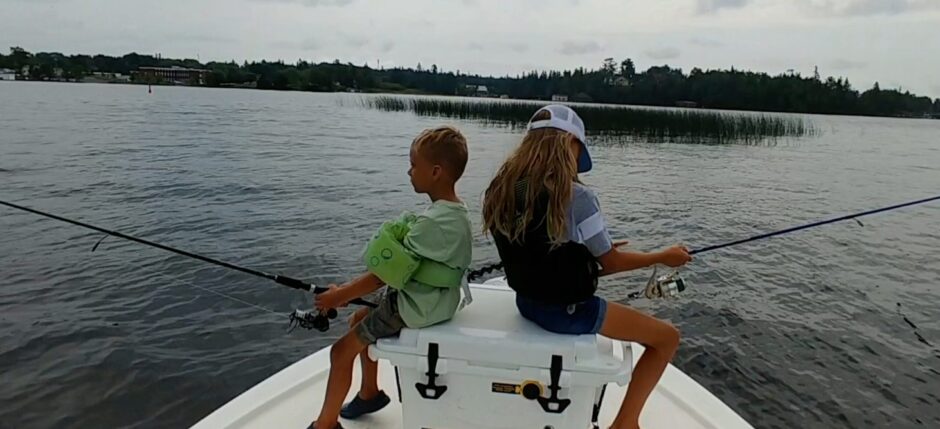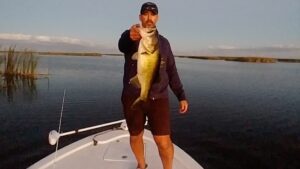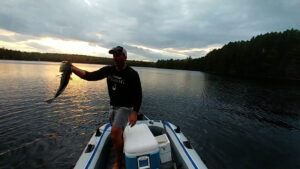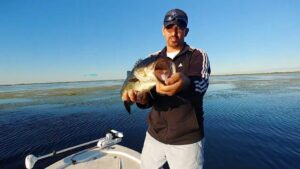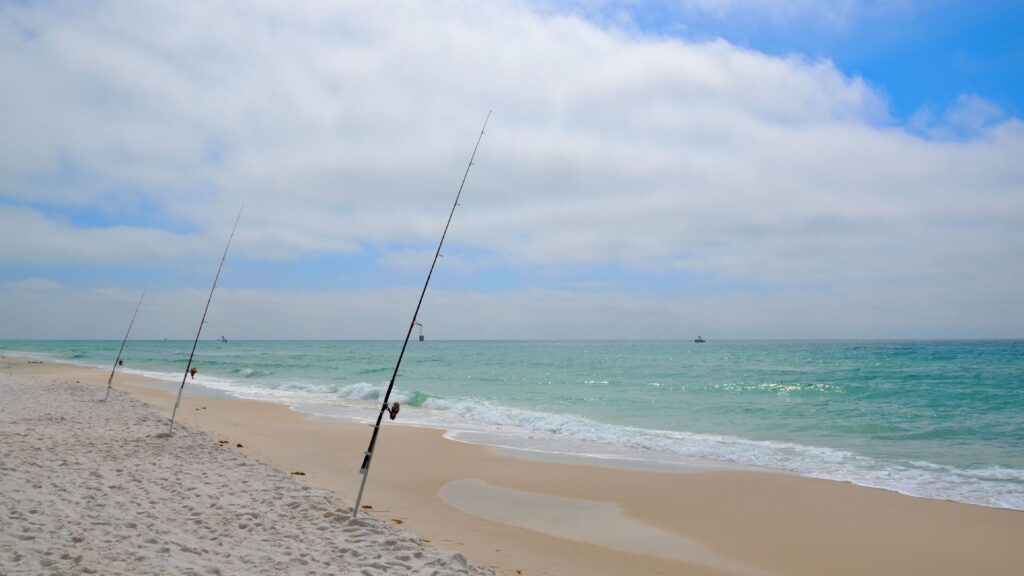
Fishing from the surf can lead to some very exciting saltwater fishing with minimal costs. Because a variety of fish feed just off the surf, anglers can catch many different types of fish. Pompano, whiting, Spanish mackerel, bluefish, redfish, striped bass and sharks are some of the popular fish that are targeted from the surf.
Recommended Tackle for Fishing the Beaches
You could keep it real simple when fishing the beaches. For smaller fish such as pompano and whiting, a medium-action fishing rod with 10 to 12 pound test line and a 1 ounce pyramid sinker should be good enough for most beaches. If the surf is a little rough, you may want to go up to a 2 or 3 ounce weight. In general, when you go a little heavier in weights, we recommended going a little heavier with your fishing line as well. If you are using live shrimp, 10 to 12 pound test line may be fine for most fish that you catch, but you will have a hard time landing a large redfish, snook or black drum in the surf. To catch larger fish, 20 to 30 pound test line may be required, especially if you are using bait fish or large pieces of cut bait. When fishing for sharks, you may need 80 to 100 pound test line and a wire leader and this still may not be enough to land some of the larger sharks that come close to the beaches.
Weights & Sinkers
Pyramid sinkers from 1 to 3 ounces will work in most situations. You can use a 3-way swivel or just leave some extra line after you tie your hook so you can tie the pyramid sinker to the end of your line. The weight should rest on the bottom and your bait will be slightly above the bottom waiting to be eaten. If you are using lighter line, a 3/4 ounce to 1 ounce sinker should be fine. If you need to use a sinker heavier than 1 ounce to stay on the bottom, we recommend using heavier line.
Surf Fishing Line
Most surf anglers use monofilament line between 14 and 20 pound test. For bigger fish, 20 to 30 pound test will work for most species. Anglers that target sharks will use even heavier line. 40 to 80 pound test will work for most situations, but make sure you tie on a steel leader to prevent sharks from cutting your line.
Surf Fishing Leaders
In many situations, you will be fine without using a leader, but there are times when a leader will help you get more fish onto the shore. In very clear water, some anglers will use a fluorocarbon leader. A fluorocarbon leader is almost impossible to see when it is submerged under water. This will help you present a more natural-looking bait. & You can tie your own leaders with a uni-knot or you can buy pre-packaged leaders from a bait and tackle shop. For those toothy-critters, a steel leader or heavy monofilament leader will be necessary to keep them from cutting your line and getting away.
Surf Fishing Lures
With all of the lures on the market, there are hundreds of different lures that will work, but we are going to cover some of the more popular lures well in the surf. Some of the smaller jigs work great for whiting and pompano, especially when tipped with a piece of shrimp. Jigging spoons most-used lure from piers and they will also work from the beach. Topwater lures can be very effective for striped bass, bluefish, sea trout and others.
Tides, Wind & Waves
The winds, waves and tides can play a huge role in surf fishing. High winds and big waves can dirty up the water real fast. In dirty water, surf fishing will typically be tough. The dirty water makes it hard for fish to find your bait and fishing will be slower for a couple of days. Slightly dirty water won’t affect surf fishing as much, but with big waves and very dirty water, you are probably better off fishing somewhere else.
Tides usually dictate when the fish will be feeding. The first couple hours before and after a changing tide will typically be better times to fish the surf and many surf anglers believe fishing an incoming tide is better than an outgoing tide. Slack tide is usually the worst time to fish the surf.
Popular Baits
Squid
Squid are very effective for fishing in the surf. You can buy squid fresh or frozen at bait shops and fish markets. Using the whole squid will work for striped bass, bluefish and redfish. For most other species, a strip of squid will work just fine.
Eels
Eels are hated by most fishermen. They can be a mess and they are hard to handle. However, eels can be an incredible bait, especially for targeting big fish. Eels in the 8 to 16 inch range seem to work best for bait, although fishermen have success with much larger eels. On the east coast, eels are a very popular bait for striped bass.
Menhaden
Menhaden are common among surf anglers on the Atlantic and in the Gulf of Mexico. Bait and tackle shops sell fresh and frozen menhaden. Live menhaden are great baits for striped bass and bluefish. Dead menhaden works for many species such as striped bass, bluefish, redfish and sea trout.
Mullet
Mullet are great baits from the Carolinas down to Florida and into the Gulf of Mexico. Mullet are a very popular bait used among surf anglers. You can easily cast net mullet from the beaches, shorelines and in the bays. Mullet can also be purchased at local bait and tackle shops. Whether you fish with mullet dead, alive, cut up in chunks or fished whole, you can catch a variety of fish in the surf with them as bait. Bluefish are the most popular fish targeted with mullet as bait, but you may catch a variety of fish in the surf or off the piers with mullet, especially if you’re using cut bait.
Clams
Clams are great baits for surf fishing. Some anglers don’t like using them because it’s tough to keep them on the hook. If you are using fresh clams, the meat will stay on the hook better. Once clams die, the meat deteriorates quickly and it will be hard to keep the bait on the hook. Frozen clams can be effective, but the fresh clams do a better job of staying on the hook. Clams will catch many species including flounder, sea trout, blackfish, striped bass, porgy, whiting, rockfish and surf perch.
Crabs
Crabs can be very effective for many different fish. Most anglers go catch their own crabs for bait. Some fishermen know how to catch them by hand, but it is much easier to catch them with a fishing line and a fresh piece of chicken or even a chicken bone. Drop your chicken down and you will have no problem catching plenty of bait. Shallow bays, creeks, canals and marshes are the best places to find crabs. A whole hard-shell crab will work well for tarpon and black drum. Soft-shell crabs are great for tarpon, black drum, snook, redfish and blackfish. Pieces of crab will work for many smaller fish.
Clam Worms
Clam worms, often referred to as ragworms or sandworms, are reddish brown with 4 eyes, 2 sensory feelers and 8 tentacles. You can find clam worms at bait and tackle shops. Some of the species that will eat a clam worm are flounder, sea trout, blackfish, striped bass, porgy, whiting, croakers, rockfish and surf perch.
Bloodworms
Bloodworms have a pinkish color as their pale skin allows their red body fluids to show through. They can found on the bottoms of shallow marine waters. Bloodworms are poor swimmers, but they are very good at burrowing into the sand and silt bottoms. Bloodworms work well for bluefish, sea trout, striped bass, whiting, flounder, porgy and others.
Sand Fleas
Sand fleas are the top bait among most surf anglers. The sand flea is not actually a crab, but it looks like a small crab and has many similarities. Sand fleas are often referred to as a mole crab. They can be caught all along the beach in the sand. As the wave recedes from the beach, look for v-shaped ripples in the sand. These are sand fleas that have dug into the sand. Dig them up by hand or with a sand flea rake. Pick up your sand fleas and put them into a container with some moist sand. If you submerge sand fleas in water, they will drown. Keep the container covered in hot weather. A damp cloth will work just fine. Now that you have your bait, set up a bottom rig with a diamond sinker, hook and a sand flea and you are ready to fish the surf. Sand fleas will catch a variety of species such as pompano, whiting, blackfish, redfish, striped bass, black drum, croakers and others.
Shrimp
You can’t really go wrong with shrimp. Shrimp will always catch some type of fish in the surf. You can use live or dead shrimp and you can fish them with a jig or on the bottom with a pyramid sinker. With dead shrimp, cut the tail and head off and just use the meat portion of the shrimp. This seems to get more bites. If you are fishing from a pier or jetty with a live shrimp, try letting a live shrimp swim freely with the incoming or outgoing tide. Just hook the shrimp in the back and use just enough weight to get it to go down. It doesn’t have to be on the bottom, but you don’t want it floating along the surface either. This may not be possible off of some piers, but there are some piers that get a strong tide and the tide will take your bait straight in front of you or behind you so you don’t have to worry about tangling somebody else’s line. If the tide pulls your bait along the side of the pier, you are going to end up tangling other people’s line, so this will not work. It can be very effective if you are in a situation where it will work.
